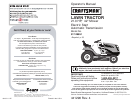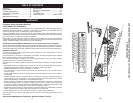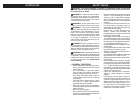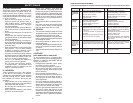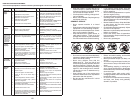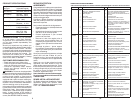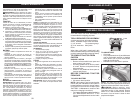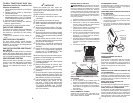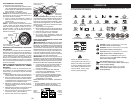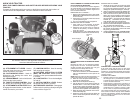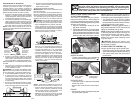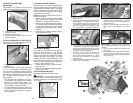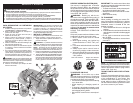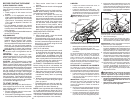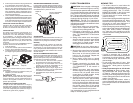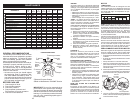
4
II. SLOPE OPERATION
Slopes are a major factor related to loss of
control and tip-over accidents, which can
result in severe injury or death. Operation
on all slopes requires extra caution. If you
cannot back up the slope or if you feel uneasy
on it, do not mow it.
• Mow up and down slopes, not across.
• Watch for holes, ruts, bumps, rocks, or
other hidden objects. Uneven terrain
could overturn the machine. Tall grass
can hide obstacles.
• Choose a low ground speed so that you
will not have to stop or shift while on the
slope.
• Do not mow on wet grass. Tires may lose
traction.
Always keep the machine in gear when
going down slopes. Do not shift to neutral
and coast downhill.
• Avoid starting, stopping, or turning on a
slope. If the tires lose traction, disengage
the blades and proceed slowly straight
down the slope.
• Keep all movement on the slopes slow
and gradual. Do not make sudden
changes in speed or direction, which
could cause the machine to roll over.
• Use extra care while operating machine
with grass catchers or other attachments;
they can affect the stability of the ma-
chine. Do no use on steep slopes.
• Do not try to stabilize the machine by
putting your foot on the ground.
• Do not mow near drop-offs, ditches,
or embankments. The machine could
suddenly roll over if a wheel is over the
edge or if the edge caves in.
III. CHILDREN
Tragic accidents can occur if the operator
is not alert to the presence of children.
Children are often attracted to the machine
and the mowing activity. Never assume
that children will remain where you last
saw them.
• Keep children out of the mowing area
and in the watchful care of a responsible
adult other than the operator.
• Be alert and turn machine off if a child
enters the area.
• Before and while backing, look behind
and down for small children.
• Never carry children, even with the
blades shut off. They may fall off and
be seriously injured or interfere with safe
machine operation. Children who have
been given rides in the past may suddenly
appear in the mowing area for another
ride and be run over or backed over by
the machine.
• Never allow children to operate the ma-
chine.
• Use extra care when approaching blind
corners, shrubs, trees, or other objects
that may block your view of a child.
IV. TOWING
• Tow only with a machine that has a hitch
designed for towing. Do not attach towed
equipment except at the hitch point.
• Follow the manufacturer’s recommenda-
tion for weight limits for towed equipment
and towing on slopes.
• Never allow children or others in or on
towed equipment.
• On slopes, the weight of the towed equip-
ment may cause loss of traction and loss
of control.
• Travel slowly and allow extra distance to
stop.
V. SERVICE
SAFE HANDLING OF GASOLINE
To avoid personal injury or property dam-
age, use extreme care in handling gasoline.
Gasoline is extremely flammable and the
vapors are explosive.
• Extinguish all cigarettes, cigars, pipes,
and other sources of ignition.
• Use only approved gasoline container.
• Never remove gas cap or add fuel with
the engine running. Allow engine to cool
before refueling.
• Never fuel the machine indoors.
• Never store the machine or fuel container
where there is an open flame, spark, or
pilot light such as on a water heater or
other appliances.
• Never fill containers inside a vehicle or
on a truck or trailer bed with plastic liner.
Always place containers on the ground
away from your vehicle when filling.
• Remove gas-powered equipment from
the truck or trailer and refuel it on the
ground. If this is not possible, then refuel
such equipment with a portable container,
rather than from a gasoline dispenser
nozzle.
SAFETY RULES
61
IDENTIFICACIÓN DE PROBLEMAS:
Vea la sección apropiada en el manual a menos que esté dirigido a un centro de servicio Sears.
PROBLEMA
CAUSA CORRECCIÓN
Las luz (ces)
de lantera(s)
no funciona-
ndo
1.
El interruptor está “APAGADO”(OFF).
1.
“ENCIENDA” (ON) el interruptor.
2.
Bombilla(s) o lámpara(s) quemada(s).
2.
Cambie la bombilla(s) o lámpara(s).
3.
Interruptor de la luz fallado.
3.
Revise/cambie el interruptor de la luz.
4.
Alambrado suelto o dañado.
4.
Revise el alambrado y las conexiones.
5.
Fusible quemado.
5.
Cambie el fusible.
La batería
no carga
1.
Elemento(s) de la batería malo(s).
1.
Cambie la batería.
2.
Malas conexiones de cables.
2.
Revise/limpie todas las cables.
3.
Regulador fallado (si equipado).
3.
Cambie el regulador.
4.
Alternador fallado.
4.
Cambie el alternador.
Pérdida de
impulsión
1.
El control de rueda libre está enla posición
“DESENGANCHADO” (dis en gaged).
1.
Ponga el control de rueda libre enla
posición “ENGANCHADO”(disengaged).
2.
Residuos es en de la placa de dirección
(Si los tiene).
2.
Vea “LIMPIEZA” en la sección de Manteni-
mento de este manual.
3.
La correa de impulsión de impulsión de
movimiento.
3.
Reemplace la correa de movimien-to esta
gastada, dañada o rota.
4.
Aire atrapado en la transporte o el servicio.
4.
Purgue la transmisión.
5.
Llave cuadrada de eje es ausente.
5.
Vea “PARA REMOVER LAS RUEDAS”
en la sección de Servicio y Ajustes de
este manual.
El motor tien
“contraex-
plosiones”
cuando se
“APAGA”
1.
El control de la aceleración del motor no fue
ajustado en la posición de velocidad media
y máxima (rápida) antes de para el motor.
1.
Mueva el control de la aceleración a la
posición de velocidad media y máxima
(rápida) antes de para el motor.
El tractor se
ponen mar-
cha atrás
1.
El sistema de funcionamiento atrás (ROS)
no está "ON", cuando enganche la sega-
dora o otro accesorio.
1.
Girar el ROS en la posición "ON".Vea la
sección de operación.



